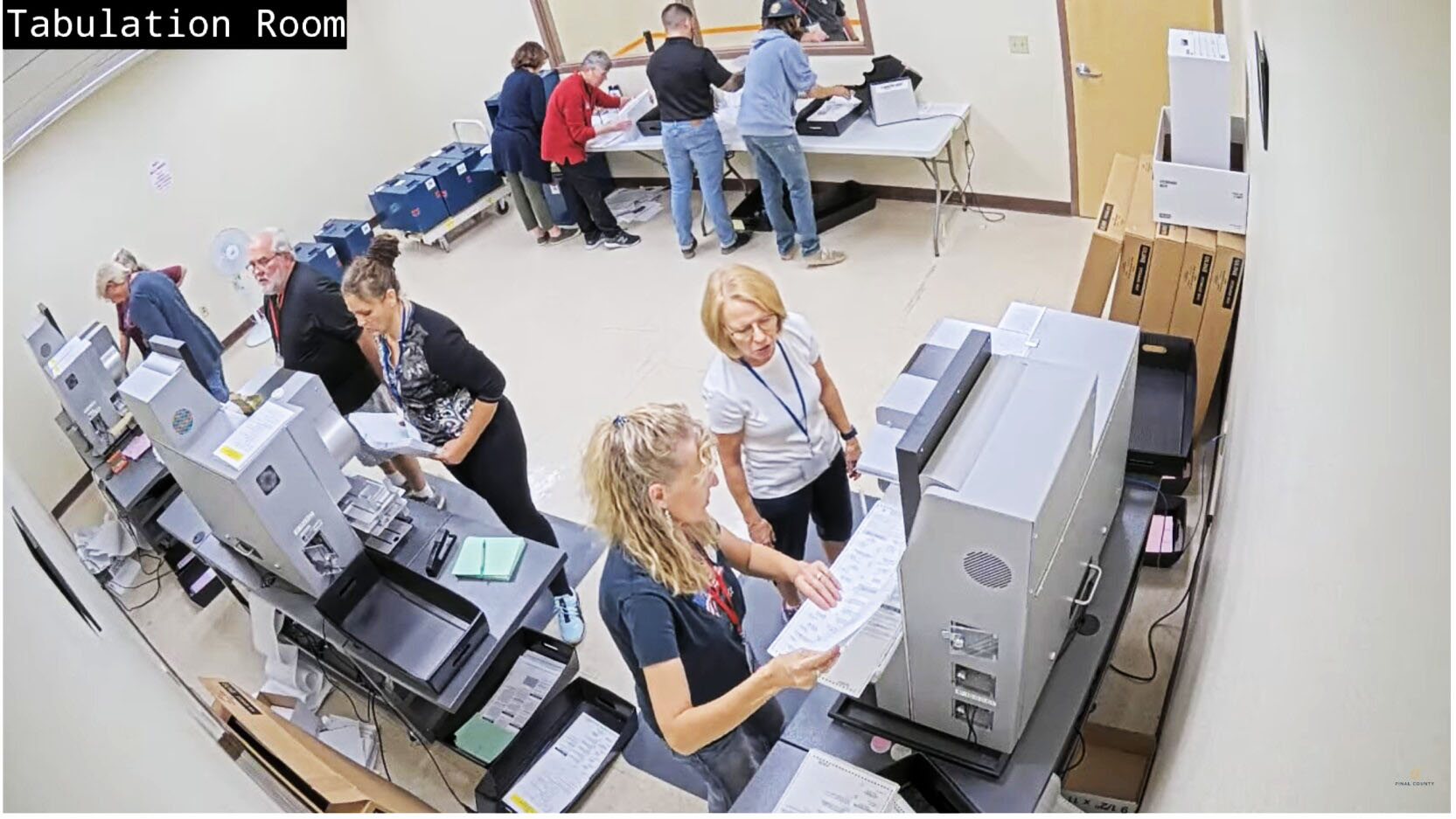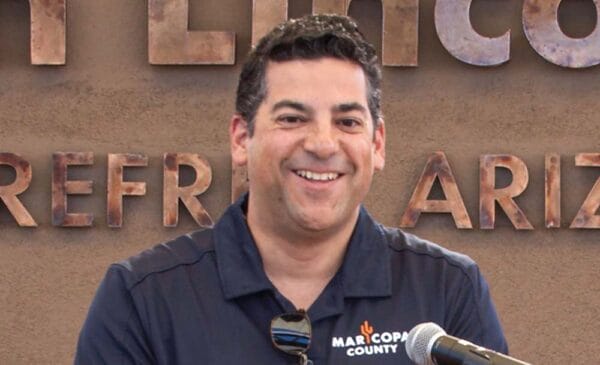The election had not entirely gone as planned, though — in ways that weren’t immediately evident. || Pinal County
Votebeat
By the time Virginia Ross appeared before Pinal County’s supervisors one last time, she had already sold her house.
The elections director just needed the supervisors to vote “yes” on Nov. 21, finalizing the November election, and she would be on her way to retirement.
“I stand by the results,” she assured them.
A lot hinged on this moment. After a primary election debacle in August, the county manager had brought Ross on to right the ship. The county paid her handsomely: more than $40,000 a month leading up to the election. That’s more than five times what the past two elections directors had made. Plus, she would get a $25,000 bonus if supervisors voted yes.
The supervisors made it easy for her: They didn’t ask her any questions, voting unanimously to certify the results. She got her bonus, and quickly moved to an East Texas town with fewer than 1,000 residents.
It would be another month before Arizona voters learned what internal evidence already showed — that Ross had botched the count in a way that excluded hundreds of votes from the original results, enough to nearly overturn the outcome of a statewide race.
While county officials have repeatedly said the county didn’t know of potential problems with the results before the supervisors’ vote, a Votebeat investigation found that election officials had documented numerous errors counting ballots and witnessed several red flags before the vote. One supervisor publicly said he had heard of problems that could have affected the count. But election officials didn’t resolve the problems, didn’t say anything publicly, and recommended certifying the results anyway.
By reviewing hundreds of internal documents, emails, and text messages as well as publicly-available meeting footage, Votebeat has found that:
- Before certifying the results, election officials had documented glaring discrepancies with Election Day ballot counts. For example, in a master spreadsheet they used to monitor the accuracy of results, the number of ballots cast at a polling place was often dozens off from the number eventually counted.
- Poll workers did not accurately track ballots at polling places across the county — and county leaders never corrected the numbers, making it harder to ensure accurate results.
- An audit board appears not to have reconciled errors before results were certified, a safeguard required by state law.
A half-dozen election experts from other states who reviewed the discrepancies in the county’s reports were shocked Pinal officials didn’t immediately hit the brakes.
“I cannot even fathom seeing those reports, seeing how the numbers were off and not doing everything I could as a leader of the organization — the person that is ultimately responsible for the integrity of the election — to figure out what happened,” said Jennifer Morrell, founder of an elections consulting firm and an expert on post-election reconciliation.
Morrell said she couldn’t believe Ross left before ensuring the results were accurate.
“As a former election administrator, the thing that shocks me is the person that was in charge just walked away without reconciling all of this,” she said. “I can’t believe she just walked away.”
The errors were only made public during December’s statewide recount, required because of tight results in three races. It revealed that Pinal election officials originally failed to tabulate hundreds of ballots cast on Election Day, and also failed to properly count some votes on dozens of others. The new tally nearly overturned the attorney general’s race.
Without the recount, the errors would not have come to light.
The recount process also showed no other Arizona county had made such significant mistakes. In today’s election atmosphere, where even the smallest problems can provoke false claims of fraud or malfeasance, election experts elsewhere told Votebeat that they were surprised by the lack of diligence, especially in a county the size of Pinal, with more than 145,000 ballots cast in the midterm. The errors in the master spreadsheet alone were alarming, Morrell said.
“I can’t imagine being off more than 10 and not panicking,” she said.

Only Pinal County Attorney Kent Volkmer — who acknowledged the gravity of the mistakes — agreed to an interview for this article, and he only agreed to address specific questions about his knowledge of events.
Other county leaders refused to talk in person or by phone and declined to answer specific questions about the documents they provided in response to Votebeat’s records requests.
In a statement to Votebeat, County Spokesperson James Daniels said the county recorder, county attorney, supervisors, and other “leadership” didn’t know about problems with the counts prior to certifying the results, but he refused to say how much election officials knew at the time of the supervisors’ vote. County leaders, he wrote, “are looking to the future and not to the issues of the past, and therefore there is no appetite to do an interview.”
Ross did not respond to requests for comment. No working phone number or email could be found, and county officials earlier this year said they had no way to relay an interview request. Votebeat mailed two certified letters, to her new address and post office box in Texas. The local post office documented receipt of both letters, though Ross did not respond.
“Just a lot of work to do”
Ross, a Republican, had been the county’s elected recorder for nearly a decade when she was put in the elections director spot. The county manager agreed to pay her such a striking sum because the county was already in recovery mode from the primary.
About one-fourth of polling places had ballot shortages on Election Day. County Manager Leo Lew swiftly fired the elections director, David Frisk, and pulled in Ross. The supervisors more than doubled her staff and said they trusted her to fix the system in the three months before the general election.
Volkmer now says that was a mistake.
“This was a result, in my opinion, of having people without a ton of experience in very important jobs and having single points of failure, not having redundancies in place to catch mistakes,” he said. “There are proactive steps the county is taking so that this doesn’t happen again.”
As recorder, Ross had experience running early voting, but tabulating and finalizing the vote totals were not among her responsibilities.

A month before Election Day, she took questions from reporters inside the historic Florence courtroom now used for supervisors’ meetings. Sitting behind a desk near the entrance, Ross told Votebeat that she had been working every weekend.
She was almost fully staffed, she said, but everyone was new. She had already rewritten the county’s poll worker training manual, created more detailed and longer in-person training, added an additional accuracy test of tabulation machines, and organized a mock election.
“There is just a lot of work to do,” Ross said.
Ross was confident in how the election would go — although she was worried about the county’s new two-page ballot. Pinal County had been forced to split its ballot into two pages for the first time anyone could remember, because of the number of contests. Officials knew that was going to make tracking and tabulating ballots logistically challenging.
The county had set up the open house in the name of transparency, but officials refused to talk about what exactly happened during the primary – they said because it was still under investigation. And they stopped short of providing explanations for the larger choices the county had made, over time, that could have prevented the problems.
Asked why voters should feel confident the November election would go well, Ross said just putting her in charge should improve public confidence. “People know me,” she said.
In his office that same day, Supervisor Jeffrey McClure — then serving as chairman — exuded confidence. The supervisors were paying Ross a high salary — first reported by The Arizona Republic — because they needed “to make this work,” he said. “The directive was what does it take to fix it, who do we need to fix it, give it to her, and go do it.”
He said he didn’t want to be like Maricopa County. “You know, always in the news.”
McClure’s quip still resonated the day after the election, when Maricopa County was consuming the media’s attention with widespread problems tabulating ballots.
Meanwhile, everything seemed to have gone well in Pinal County. County officials highlighted a few “minor errors,” including a noticeable delay in reporting election results they said was caused in part by the two-page ballot. But, otherwise, county supervisors praised the elections team for a job well done.
“It was good to not be the center of attention, bottom line,” Supervisor Mike Goodman said. “I’m pretty confident that we have put back the confidence of our voters here in Pinal County.”
“An absolute nightmare”
The election had not entirely gone as planned, though — in ways that weren’t immediately evident.
For one, election officials hadn’t properly loaded voter registration information into the county’s database before the election, so poll workers couldn’t properly check some voters in on Election Day — a problem county officials eventually acknowledged publicly.
Also, the forms that poll workers used to outline how ballots were used at their locations, called “ballot reports,” were filled with errors, according to copies provided to Votebeat — perhaps because of a confusing form, the two-page ballot, lack of proper training, or all three. The forms ensure that the correct number of ballots have been counted and are all returned from the polling location, but poll workers appear to have not understood which numbers they should put where when filling it out.
Recently shown Pinal County’s forms, Morrell and Michele Forney, elections director in Pinal until 2019, said the paperwork was confusing and that they were unsurprised by the number of errors.

The errors on those reports were “an absolute nightmare,” and had immediate repercussions on election night, said Jennifer Hilsbos of San Tan Valley, an official political observer for the Democratic party that night.
Workers who received the ballots at the county’s election headquarters tried to sort out the numbers but often were unable to reach poll workers, Hilsbos said. This meant the temporary workers charged with tabulating the ballots often didn’t know exactly how many ballots they should have to begin with, making it difficult for them to check their work as they went.
They didn’t realize at the time that, as paper jams occurred and other small mistakes piled up, some ballots were never tabulated. Also, county officials had erred while programming the machines, causing them to fail to count unclear votes on some ballots, which means some ballots were only partially tabulated. The county disclosed that in a report on the problems released after the recount results were announced. Workers also failed to use a separate log to compare the starting number of ballots to the number of ballots they’d scanned, which experts agree is a best practice.
Maricopa County, for example, has detailed and clear forms for this point in the process. The number of ballots cast and then tabulated is tracked by machine, batch, and day. Maricopa Elections Director Scott Jarrett said discrepancies are resolved on the spot — workers and supervisors move into a separate room to huddle and figure out what’s wrong. In 2022, he understood his numbers down to the last ballot, he said.
None of this appears to have happened in Pinal County, where ballot counting stretched into the early hours of the day after the election — most workers didn’t leave until 4 a.m., logs provided by the county show.
Red flags prior to certification
A little-noticed sign the results were off came during the county’s required hand-count audit a few days after the election, when political party appointees counted the votes cast in four randomly selected races on a small percentage of early and Election Day ballots.
As workers hand-counted ballots from two polling places, or about 435 ballots total, they tallied one extra vote for three candidates in three of four races. No one could figure out why, but they carried on anyway.
Geraldine Roll, who was a deputy county attorney at the time in training to replace Virginia Ross as the next elections director, mentioned this five days later as she updated the supervisors as to how the counting was going.
“The board spent several hours trying to figure out where that discrepancy came from, and finally determined that because it was under the margin of error they would move on,” Roll said at the Nov. 16 supervisors meeting. The root of the problem — that the county had originally failed to tabulate two ballots from one of those precincts — was not unraveled until the recount results were final on Dec. 29.
Roll also told county officials that, as of the Nov. 16 meeting, she was unaware of how many unused ballots were left over at polling places, something other election officials told Votebeat should have been obvious from the ballot reports. She did not highlight any problems with these forms at the meeting.
Instead, she told the supervisors that elections staff would compare the number of unused ballots with the used ballots and cast ballots to verify the results prior to certifying them. Ross, the elections director, had previously told supervisors that they would use a master spreadsheet to track everything, which would allow them to spot errors and balance the numbers before the results were certified — a process also called a canvass.
A copy of this spreadsheet obtained by Votebeat shows that it was never balanced.
For example, on the first row, which shows data from the county’s first precinct — the small eastern Pinal town of Kearny — workers reported that voters cast 308 ballots. But the number of ballots counted by the tabulation machines from that location only says 210. The recount found that the county originally failed to tabulate 90 ballots — nearly one-third of all ballots from voters in the town.
After the recount results were announced, Roll, the elections director in training, told supervisors that looking at the numbers for this precinct had made her think “hmmm,” but it isn’t clear when she first saw them. Neither she nor other county officials would comment on why the election was certified despite the obvious errors, nor would they say who had access to the spreadsheet prior to the vote. The document’s properties show it was created by Ross.
Minimally the “audit board” — which election directors are legally required to assemble — should have reviewed the numbers. By law, their work includes sifting through documents containing ballot and voter numbers to verify the results, according to requirements of Arizona’s Elections Procedure Manual, a detailed document outlining how elections must be run in the state that has the force of law.
The audit board must resolve errors before the results are certified, according to the EPM. The county didn’t provide any documents showing that this occurred. Also, the audit board should have met between when officials finished counting ballots and when the elections director packaged the results for the supervisors’ approval.
In Pinal County, the time period for holding that meeting was “a half-hour or so” on the afternoon of Nov. 17, according to Roll.
Supervisor Kevin Cavanaugh, after reviewing Votebeat’s findings, said he wanted to know how the county could have met the audit board requirement.

Roll revealed to the supervisors at a Jan. 4 meeting that she had seen enough potential problems in the results before the supervisors’ vote to believe they should postpone certifying while they looked into them, and it wasn’t her decision to go ahead. There was still more than a week left before the county’s deadline to finalize results. It was Ross’ decision to move forward when they did, Daniels, the county spokesperson, wrote in a statement.
Roll didn’t raise her concerns publicly or to Volkmer at that time, though, according to Volkmer. Neither did Scott Johnson, an attorney who was working closely alongside Ross and Roll on a temporary assignment as deputy elections director and who was looking into errors in voter numbers before the certification, according to an email he sent to the secretary of state’s office.
It was Roll, not Ross, that was actively supervising tabulation on election night, according to Hilsbos, the observer. Key card logs show both Roll and Johnson were in and out of ballot storage repeatedly in the days just before the results were certified. Roll and Johnson declined to comment on what exactly they knew about the problems and when. By the time the certification of the results took place on Nov. 21, these election officials had not publicly discussed any major errors.
The same week Ross made the decision to move forward, she sold her San Tan Valley house, county property records show.
“No irregularities”
During the supervisors’ meeting the morning of Nov. 21 — just before they voted — Supervisor Jeff Serdy said that although he didn’t “really want to discuss it now,” he was hearing about “issues” that could have “affected the count.”
Volkmer, the county attorney, responded with surprise, saying this was “news to him” and “everything would suggest there has been no irregularities.”
No one suggested looking into this further before certifying.
“I can tell you that I am incredibly confident, as confident as I could possibly be, in the numbers that are being provided to this board,” Volkmer said. “I don’t believe there is anything nefarious.”
The day after the results were certified, Lewis, the recorder, emailed an employee in the secretary of state’s office with the subject line “Situation – Pretty Important,” saying she was seeing discrepancies when looking at early voting totals.

While Lewis declined to speak to Votebeat about her email, the employee at the secretary of state’s office explained in detail that this referred to an unrelated problem that didn’t affect the county’s election results. Still, it’s unclear why Lewis hadn’t noticed and resolved these discrepancies in her numbers prior to the county certifying results.
That same day, the day after the certification, Ross was quoted in a local newspaper saying that she was aware that some workers hadn’t followed procedures when a ballot failed to tabulate properly.
“We had a couple of instances where our poll workers needed a little more training on how to handle that scenario, but that will be addressed in some post-election training we’ll be implementing,” she told the reporter.
The county became one of the first, to certify their results. Under state law, they still had another week before the deadline.
“In a difficult spot”
Geraldine Roll officially signed a contract to take over for Virginia Ross on the last day of November — two working days before Arizona certified its statewide results. Her contract came with a $154,000 salary. The two most recent election directors, Frisk and Forney, had both made about $100,000.
That same day, Roll called Volkmer to tell him she knew that 245 ballots had not been counted across four precincts, according to Volkmer. Despite the imminent statewide certification, Volkmer told Votebeat no one mentioned these errors to the secretary of state’s office.
The state then certified the results on Dec. 5 and the court ordered the statewide recount, barring county and state officials from talking about recount results. County and state officials say they took that as a gag order preventing them from talking about errors in the original count.
County officials say they first told the secretary of state’s office about errors in the results on Dec. 7 — more than two weeks after the county certified its election. A spokesperson for Gov. Katie Hobbs — a Democrat who was secretary of state at the time — explained that her office did not share this fact in court proceedings over the results, including losing Republican attorney general candidate Abe Hamadeh’s election contest, because of that gag order.
Asked why the county did not say anything publicly or to the secretary of state’s office about the errors during the short period between when Volkmer knew about them on Nov. 30 and when the gag order was issued Dec. 5, Volkmer said that county officials knew a recount would be ordered because of the tight results and — because the county had already certified results — officials saw it as their only real way to recount all ballots effectively. “We were in a difficult spot where we didn’t have the ability on our own to do the recount,” he said.
If the county didn’t believe a recount would happen, he said, “we probably would have taken a different position.”
Once the errors were announced publicly, some residents said in public comments at a Jan. 4 meeting that county officials should have said something sooner. Ally Miller, a former Pima County supervisor, questioned why Volkmer didn’t notify the court in the Hamadeh case.
“Why didn’t your attorney, who is an officer of the court, notify the court of these discrepancies?” Miller asked supervisors. “I know it is the duty of the secretary of state to report that. She didn’t, and I think everyone was watching that.”
Cavanaugh, the only supervisor that responded to Votebeat’s request for an interview, said if the recount hadn’t happened, “these errors and bad practices would never have been discovered.”
“How long have we had chain of custody and counting errors?” he said.
After overlooking 442 ballots, a $25,000 bonus
On Dec. 16, as the recount progressed in Arizona, Virginia Ross finalized the deed on a newly-constructed house down a two-lane road in East Texas.
Around the same time, Pinal officials decided they didn’t feel confident in their initial recount and would start on a third count of the Election Day ballots.
When the recount results were released on Dec. 29, they showed a laundry list of easily preventable problems. Among them: Because of worker errors programming and operating ballot tabulators, the county had entirely failed to count 442 Election Day ballots. The county had also failed to count some votes on 63 other ballots, in races where voter selections were unclear.
The recount had included three races: the attorney general race, the state superintendent race, and — in a different part of the state — a legislative race.
Prior to the recount, Democrat Kris Mayes was leading Hamedeh in the attorney general race by 511 votes statewide. In the recount, Hamadeh picked up 392 votes in Pinal County and Mayes gained 115. Statewide, Mayes’ lead shrunk to just 280 votes out of more than 1.25 million ballots cast.

At the first public meeting after the results were announced, on Jan. 4, residents said they were astounded by the mistakes. Pete Sabin of Marana pointed out that, if looking just at the 36,000 Election Day ballots, there was about a 1.4% error rate.
“We wouldn’t tolerate this with our money in banks if it was being counted with that level of inaccuracy, and we shouldn’t allow that with our vote, which arguably is much more important to a republic,” Sabin said.
Miller and other residents said they were offended by Ross’ high pay and bonus, and told supervisors to try to get the $25,000 back.
At least one supervisor was interested in trying to claw back the bonus, which was tied to a few requirements, including successful training of poll workers. At a meeting to discuss this on Feb. 1, Volkmer told supervisors the county was setting itself up for a losing legal battle if it tried to get the money back, because of the way the contract was written and because poll worker training still had improved from the primary.
At that meeting, County Manager Leo Lew said that Ross had written the terms of the contract herself, he approved it, and he didn’t run it by Volkmer before finalizing it.
Lew defended the terms, the high rate, and Ross.
“I think that Virginia did substantially do her job and I think she did substantially fulfill this contract and I’m grateful that she did,” Lew said.
Ross had asked for such a high rate in part because, county officials said she told them, by leaving her position as recorder before she hit the 10-year mark, her pension would be calculated at a lower rate. But elected officials’ pension rates do not increase at the 10-year mark, according to officials with the state’s retirement system. The only additional credit Ross would have received would have been for additional months in the system.
As it is, she receives $1,549 per month.
Moving forward, the state has been working directly with Pinal County to try to improve their processes, said Paul Smith-Leonard, communications director for current Secretary of State Adrian Fontes, a Democrat. He said it is “clear they understand the cause of the issue and plan to ensure procedures are followed going forward to prevent it.”
“Our office has met with Pinal to communicate about required election processes and helped connect Pinal with other election subject matter experts around the state and country to help them build in some best practices,” he said.
Fontes is also asking the state legislature for six additional positions in his office to support, guide, and train counties, he said in a written statement.
His office will host election officer certification training starting in June, and it “will include specific guidance to help ensure that issues like those that occurred in the last election, do not happen again,” Fontes wrote.
For Pinal County’s part, leaders are trying to build out a team of experienced election officials around Geraldine Roll, and are working to create more substantial oversight for future elections, Volkmer said, such as building an internal procedures manual and adding audits.
County officials refused to answer specific questions from Votebeat for this article, but after receiving them, Roll addressed some publicly on May 3.
Elections staff are making poll worker forms easier to understand, better training staff on how to tabulate ballots, and adding more documents to track ballots during tabulation, Roll told supervisors.
“I have no plans in bringing you a canvass I’m not 100% confident in,” Roll said.
In a phone interview after the meeting, Cavanaugh said the county needs to have a fuller discussion.
“If we can’t acknowledge the problems that have occurred in the past, we are not likely to fix them,” he said.
“Sweeping them under the rug is not a good policy.”












